The Lawmatics Blog
Insights on legal marketing, automating the law practice, and legal tech in general
About the session
Behind every great client experience is a system quietly keeping things on track. The newest automation updates in Lawmatics build on that foundation, making it even easier to build and manage their automated workflows.
In this session, Devon Butler and Clare Struzzi walk step-by-step through what’s new. They cover trigger-based automations, appointment workflows, shared entry rules, and a simple way to organize everything in folders. Together, these improvements give firms even more control, flexibility, and time back in their day.
Webinar slide deck
In today's fast-paced legal landscape, agility and responsiveness make all the difference in converting leads into loyal clients. But all too often, law firms rely on fractured, manual, and archaic methods for welcoming new leads. That’s why legal professionals are turning to reception tools like Answering Legal and CRM platforms like Lawmatics to create client-centered experiences that win their firm more business.Without having to do a thing, you can have prospective clients welcomed to your firm, taken through a full legal intake process, and have all of their personal case details organized into a form. Here’s Lawmatics Product Manager Devon Roth and Answering Legal Marketing Director Nick Werker to explain how.
Time Stamps of Key Takeaways
0:00 — Introductions
Meet Devon and Nick, and learn a little about their respective roles at Lawmatics and Answering Legal. If you’re a fan of adorable pooches, you may also want to hear their fun facts.
10:24 — How to increase your odds of connecting with new leads
Nick starts by sharing some data and perspective on how clients expect to connect with attorneys. The theme here is that firms have to be flexible in how they receive new leads. In this day and age, you may be missing out on business if new leads can’t reach out to you after your office hours.
13:21 — Streamlining your client intake process
A major component in creating that flexibility is having an intake process that’s simple and efficient. It frees up your staff to be agile and responsive to clients and leads. Here, Devon outlines the tools that define a streamlined intake pipeline.
18:21 — Using Answering Legal & Lawmatics together!
For law firms in need of more efficient systems to better respond to clients, Answering Legal and Lawmatics offer a powerful one-two punch for reception and intake. In this section, Nick explains how the integration between the two services works, and the impact our partnership has on day-to-day operations.
20:46 — Q&A
Stick around to the end because our live audience brought a lot of awesome questions to this session. They ask Devon and Nick to dive deeper into even more specific ways that Lawmatics and Answering Legal can each strengthen your relationships with qualified clients.
Webinar slide deck
A legal client intake form is a crucial document used by law firms to gather essential information about a client and their legal matter. Legal client intake automation, including the use of an intake process template, streamlines the intake process so legal teams can prioritize casework. By establishing a clear and consistent process for client intake, you can save time, eliminate pesky errors and keep everyone in your practice on the same page.
What information does the client intake form collect?
A client intake form collects various information the legal team will need to handle a case, including:
- Client Information:
- Full name
- Date of birth
- Contact information (address, phone number, email)
- Occupation
- Legal issue details:
- Description of the legal issue or matter
- Date the issue arose
- Other relevant dates, events, or deadlines
- Names and contact information of other parties involved
- Case history:
- Any previous legal actions or proceedings related to the issue
- Current or previous legal representation for the matter
- Financial information:
- Billing information
- Fee structure (hourly rate, flat fee, contingency fee, etc.)
- Retainer agreement details
- Payment preferences
- Conflicts:
- Any potential conflicts of interest with the law firm or its attorneys
- Previous relationships with opposing parties or attorneys
- Documentation:
- Copies of relevant documents (contracts, agreements, court orders, etc.)
- Any correspondence related to the legal matter
- Goals:
- Client objectives and desired outcomes for the case
- Expectations regarding communication and updates from the attorney
- Confidentiality:
- Explanation of attorney-client privilege and confidentiality
- Consent for the law firm to use and share client information
- Authorization:
- Consent for the law firm to represent the client in the specified matter
- Signature of the client and date
Additionally, firms must ensure that their intake process complies with relevant legal and ethical requirements, including client confidentiality and data protection laws.
What should a client intake form include?
Intake form should be tailored to the specific practice areas and needs of the law firm. For example, in addition to the above information, an intake form for a personal injury attorney should include:
- Incident details:
- Date, time, and location of the accident or incident
- Description of how the accident occurred
- Parties involved (including witnesses, if any)
- Police report information (if applicable)
- Injuries:
- Description of injuries sustained in the accident
- Medical treatment received and healthcare providers involved
- Hospitalizations or surgeries
- Current medical condition and ongoing treatment needs
- Insurance:
- Details of the client's insurance coverage (health insurance, auto insurance, etc.)
- Information about the at-fault party's insurance (if known)
- Damages:
- Property damage incurred in the accident
- Lost wages or income due to inability to work
- Other financial losses incurred (e.g., medical bills, rehabilitation expenses)
- Witnesses:
- Names, contact details, and statements of any witnesses to the accident
- Visual evidence:
- Photographs or videos of the accident scene, vehicles involved, or injuries sustained
- Medical records:
- Authorization to obtain medical records and bills related to the injuries
- Copies of any medical reports or documentation already obtained by the client
Automated client intake form templates make it easy for firms to create their own intake process and efficiently capture the client information they need according to the practice area.
What is the purpose of an intake form?
A legal intake form gathers vital information about a prospective client and their legal issue that an attorney needs to assess the situation, evaluate the viability of the case, and determine whether they can provide assistance. When a prospective client completes the intake form, they formally engage with the attorney and give consent to seek legal advice and representation, which establishes the attorney-client relationship.
How do you write an intake form?
While intake forms were traditionally created manually and required a considerable amount of work, lawyers who handle their client intake process efficiently rely on legal intake software. A well-constructed intake form includes fields for a client’s basic information including name, address, contact details, and the details about the nature of their case. The more details that are requested on an intake form, the better a lawyer can qualify a lead before setting an appointment. Client intake software creates customized templates for lawyers that can be repurposed for each practice area in a firm and inputted directly into the law firm database, accelerating the process and reducing errors.
What is an intake form example?
Custom intake forms make it easy to qualify new prospects, organize contact information, and feed new matters into your automated processes. Here’s a client intake form example:
Is Your Firm Struggling with Client Intake? Lawmatics Has the Answer
Lawmatics offers best-in-class tools for legal client intake automation and much more. Are you ready to learn how to accelerate the growth of your firm by engaging and retaining new clients faster and more efficiently? Get a demo today.
Client intake is extremely important for law firms, as it establishes the attorney-client relationship and converts a prospect into a paying client. Although law firms traditionally completed intake manually, legal client intake automation and the use of intake process templates can dramatically streamline the process by engaging and retaining new clients faster than ever before.
What is the intake phase for a law firm?
The intake phase is the first step that potential clients take. An efficient intake process is critical to ensure that a law firm can effectively evaluate potential cases, provide appropriate legal advice, and ultimately provide solid legal representation. Here’s a client intake process example utilizing automation:
Dana is looking for legal help and reaches out to an attorney by filling out a custom intake form directly embedded into the firm’s website. She schedules an appointment with the firm’s legal calendaring software, and receives an automated reminder. Before the appointment, the firm’s technology automatically pre-screens the case for viability and performs a conflict check. She then attends the appointment and decides to hire the attorney. A retainer agreement is automatically generated which Dana signs electronically, after which it is sent back to the attorney for signature. Work on the case can begin.
How does the intake stage work?
The intake stage generally involves engaging with potential clients through initial contact, screening for case viability, conducting conflict checks, and setting up consultations to establish the attorney-client relationship. Many firms perform manual client intake processes, which can present several challenges. Manual intake workflows tend to be:
- Time consuming. Manual intake is time consuming and involves significant time and effort, which can lead to delays in retaining new clients.
- Error prone. Manual data entry increases the risk of typos, missing information, inaccuracies, and other errors.
- Limited access. Paper-based intake forms are often difficult to access and share among staff members, particularly if they are stored in physical files across various locations.
- A security risk. When sensitive client information is stored in paper files or shared via unsecured channels, this can expose the firm to data breaches and regulatory noncompliance.
- A bad client experience. Lengthy and burdensome intake processes can lead to client frustration and dissatisfaction and as a result, they might look for firms with more streamlined processes.
When firms automate their intake process, they can improve efficiency, accuracy, and client service while reducing risks and costs associated with manual methods.
What are the parts of the intake process?
Here’s are the typical steps taken during the client intake process:
- Initial contact. Potential clients often reach out to a law firm via phone, email, or through the firm's website contact form and fill out a questionnaire to provide basic information about their legal issue and their interest in obtaining legal representation.
- Screening. The law firm's intake team or attorneys gather more details about the legal matter, such as the nature of the issue, relevant dates, parties involved, and any prior legal actions taken.
- Conflict check. The firm will conduct a conflict check to ensure that there are no conflicts of interest that would prevent them from representing the potential client, including any prior or existing relationships with parties involved in the case.
- Consultation. If the case passes the initial screening and conflict check, the potential client may be scheduled for an initial consultation to review the details of the case, discuss the legal options available, and provide preliminary advice on how to proceed.
- Retainer agreement. If both the client and the attorney agree to move forward with representation, they will typically sign a retainer agreement outlining the legal fees, scope of services, and other relevant terms and conditions.
What are the objectives of the intake process?
The legal intake process has several critical objectives, including:
- Gathering information. Essential information about potential clients and their legal issues is gathered during intake.
- Managing risk. By conducting conflict checks and screening potential clients, the intake process helps manage the ethical, legal, and reputational risks of taking on a new case.
- Setting expectations. During intake, attorneys set clear expectations with potential clients about the scope of the representation, legal fees, timelines, and potential outcomes.
- Building relationships. Effective intake procedures allow attorneys to establish positive relationships with potential clients, fostering trust, confidence, and rapport.
- Streamlining workflow. A well-designed intake process helps reduce administrative burdens, minimize redundancies, and improve overall efficiency.
An efficient legal intake process lays the foundation for successful attorney-client relationships and effective representation.
How do I create a client intake for a law firm?
A law firm client intake process template can help firms establish a clear, consistent, and efficient intake process. Here’s a law firm client intake process flow chart that illustrates how automated intake works:[caption id="attachment_6228" align="alignnone"]
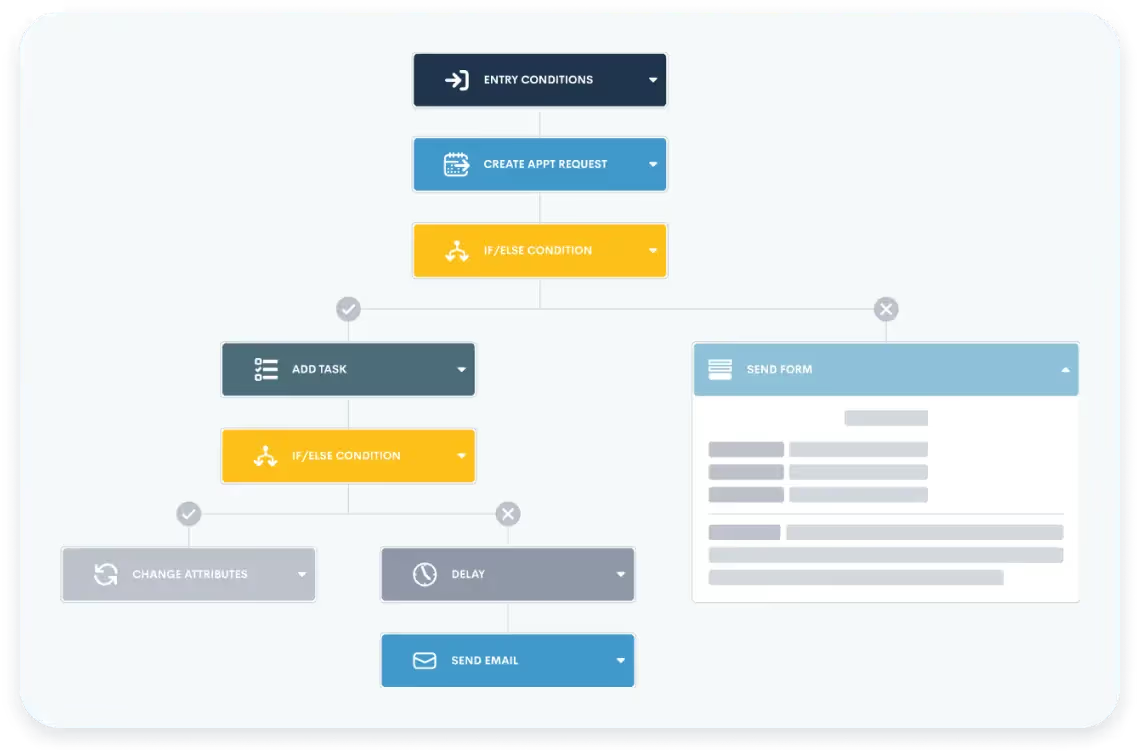
Source: Lawmatics[/caption]With automated intake, potential new clients can seamlessly submit an inquiry to a firm via user-friendly software that will optimize the intake process and quickly convert prospective clients into paying clients.
Lawmatics: the intake answer for law firms
Investing in a client intake software system won’t just make your job easier; it can dramatically impact your profits. To learn more about how Lawmatics client intake software can help organize your leads, optimize client follow-ups, and secure more business, download our e-book, “How to Gain More Business, While Saving Time with Client Intake Software” today.
April Fools’ Day may have been last week, but these new features are no joke. We’ve got a trio of updates for managing your matters, calendars, and finances. You’ll also find some quality-of-life tweaks that’ll simplify things for our intake coordinators and office managers out there.
Filter and sort your table of matters
We've revamped our classic matter table for a smoother user experience. Now, you can place your important data front and center by creating custom filtered views of all your matters with any contact, company, or matter fields that exist in your Lawmatics account. Easily customize your views to match your workflow. Navigate to CRM > Matters to get started. More customization abilities coming soon!
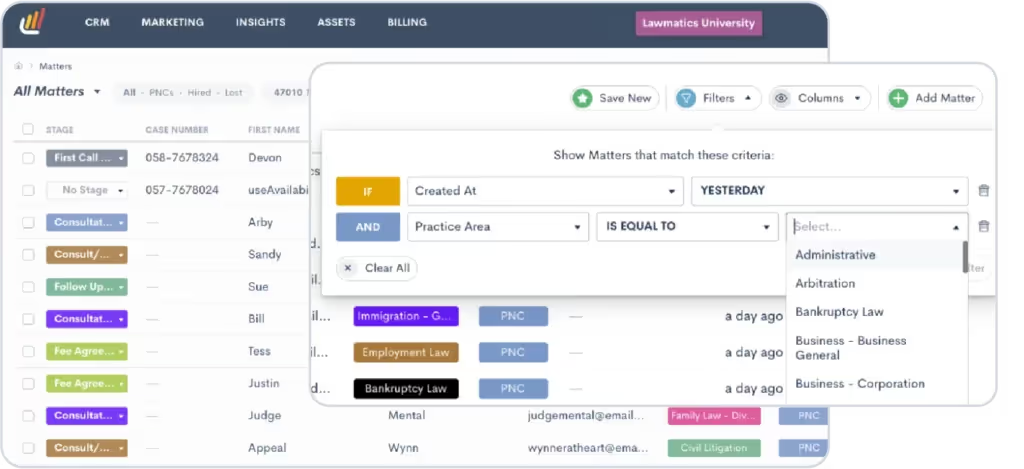
Learn how to create filtered views here.
Confirm availability for all staff appointments
Schedule consultations and follow-up meetings without fear of double-booking any of your team members. Previously, the calendar availability of other Lawmatics users at your firm could only be previewed when scheduling via a custom form. Now, users can check the availability of event hosts at their firm upon creating an appointment from anywhere in Lawmatics — whether it be on the calendar page, a matter’s page, or from the quick use menu. Coordinating staff calendars just got a whole lot easier.
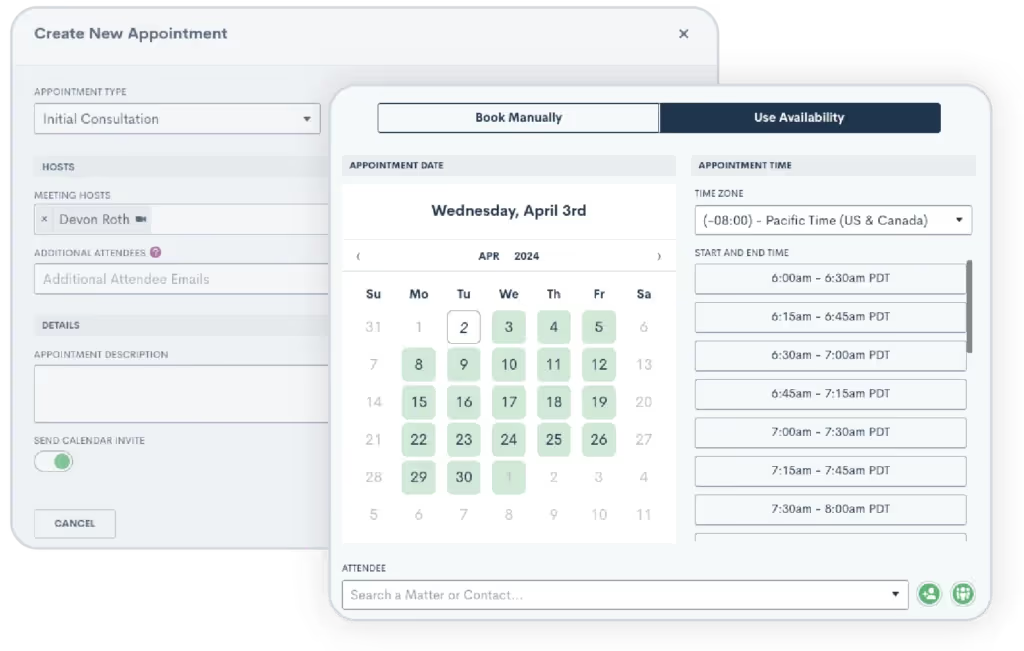
Learn more about booking appointments here.
Sophisticated financial tracking with custom transaction reports
Effortlessly analyze your firm’s financial health by mixing and matching the data you need. In addition to our existing invoice and time entry reports, you can now generate custom transaction reports. With customizable columns and filters, you can extract insights on line items like invoice numbers and payment methods that are as granular or broad as you need them to be. Plus, you can add these transaction reports to your custom dashboard should your firm need these numbers top of mind.
NOTE: This feature is only available to our Time & Billing users.
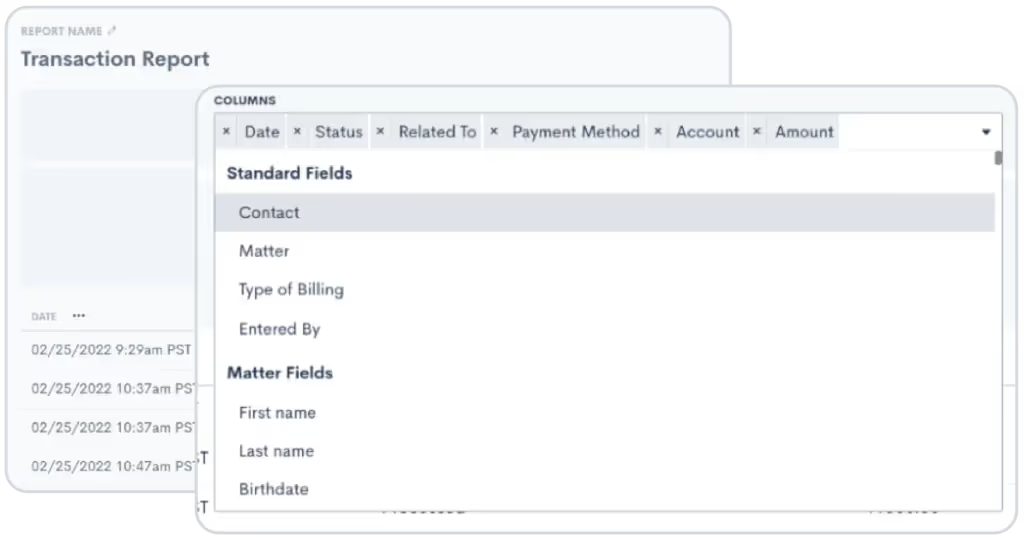
Learn more about time & billing reports here.
Send calendar invites on behalf of appointment host seamlessly
For those of you who set appointments for colleagues, you can now send calendar invites on behalf of the appointment host with greater ease, provided said host has their personal calendar (such as Google or Outlook) linked to Lawmatics. Previously, creating appointments for other users was done via the “Send Calendar Invite” toggle in the scheduling module and only if your personal Lawmatics user account had a calendar connected. This update means you can effortlessly dispatch invites on behalf of others without needing your personal calendar connected, simplifying your planning process and facilitating smoother coordination.
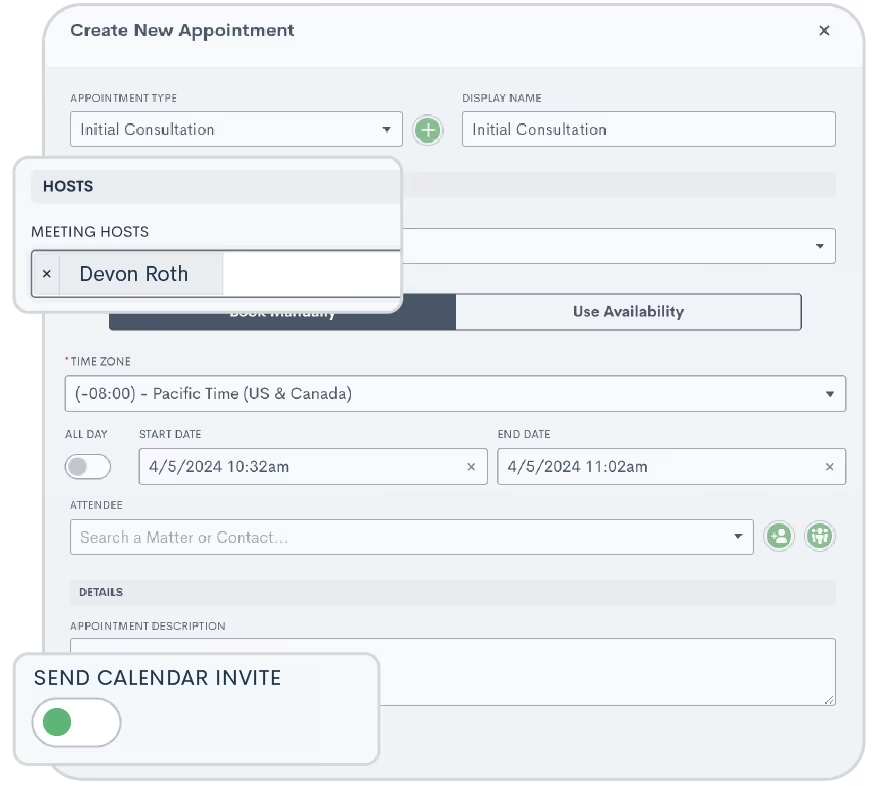
Click here to learn about appointments.
Create Zoom appointments on behalf of appointment host seamlessly
While we’re at it, you can now also set Zoom as the location when scheduling meetings for colleagues through Lawmatics, without requiring your personal user to be integrated with Zoom. The appointment host just needs to have Zoom linked to their own Lawmatics account. This update simplifies setting up video consultations and remote meetings, making coordination smooth for intake coordinators and office managers.
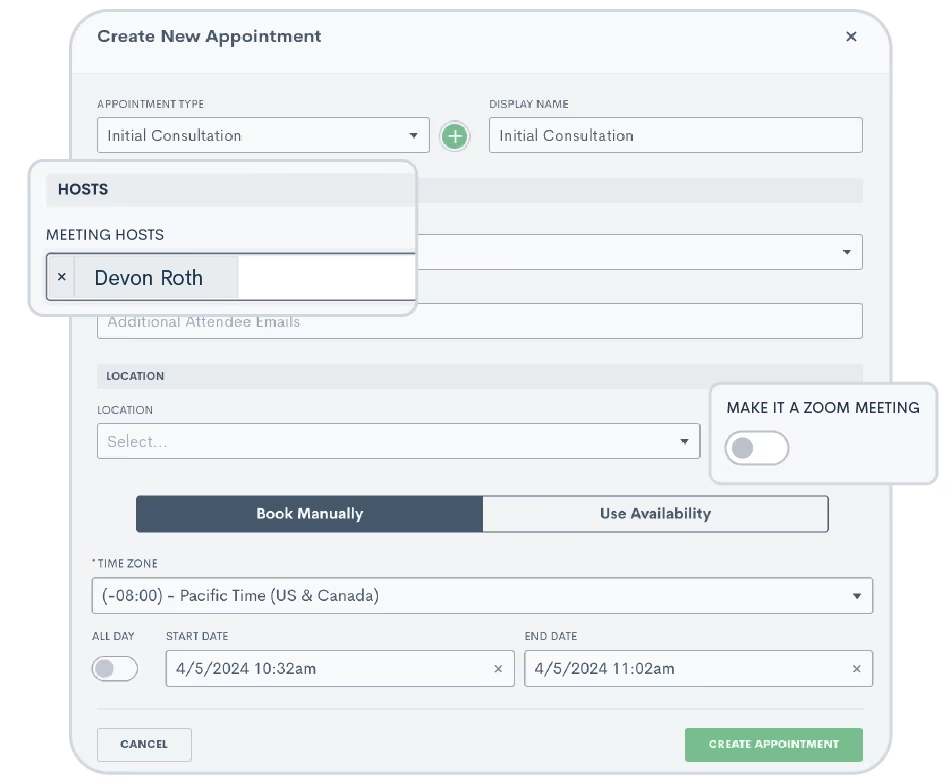
Learn more about our Zoom integration here.As always, we love your feedback and encourage you to reach out with any questions or suggestions. Thank you for being a valued member of our community. Together, we continue to push the boundaries of what's possible for law firms.Sign in or sign up to get started with Lawmatics today.
Choosing the best legal software for business billing depends on various factors such as the size of the firm, specific needs, budget, and preferences. Fortunately, comprehensive legal billing software for small firms can track billable hours, generate invoices, and manage client accounts efficiently.
How do You Simplify the Billing Process at a Law Firm?
Some strategies to simplify the billing process include:
- Standardizing billing practices across the firm with consistent templates, billing codes, and invoicing procedures
- Setting clear billing guidelines that outline rates, billing increments, and accepted payment methods
- Using legal billing software that automates time tracking, invoicing, and payment processing
- Integrating legal billing tools with case management systems to easily track billable hours and expenses
- Accepting online payments is convenient for clients and encourages them to pay promptly
For law firms, the time between completing a task and collecting a client’s payment is critical. When you streamline the billing process at a law firm, you can significantly improve efficiency and reduce administrative burden. Plus, simplifying the billing process shortens the time frame and increases profitability.
What is a Good Billing Software for Law Firms?
Before choosing billing software, a law firm should ensure that the system meets its specific needs and requirements. Here are some important considerations to make:
- Features: Evaluate the features offered and determine if they align with the firm's billing processes and requirements.
- Ease of use: Choose billing software that is intuitive, user-friendly, and easy to navigate, with clear instructions and minimal training requirements.
- Customization options: Look for billing software that provides the ability to customize invoice templates, billing rates, billing codes, and reporting formats.
- Integration capabilities: Ensure that the software integrates seamlessly with other systems used by the firm, such as practice management software, accounting software, and document management systems.
- Scalability: Choose a billing system that can scale with the firm as it grows to accommodate an increasing number of users, clients, and matters without sacrificing performance or functionality.
- Cost and pricing structure: Evaluate the cost of the billing software, including any subscription fees, implementation costs, and additional charges for add-on features or support services.
- Customer support and training: Look for vendors that offer responsive customer support, comprehensive training resources, and ongoing assistance to address any issues or questions that may arise.
- User reviews and recommendations: User reviews and recommendations from peers can provide valuable insights into the software's strengths, weaknesses, and overall suitability for the firm's needs.
The right legal billing software will enhance a firm’s efficiency, accuracy, and client satisfaction with the billing process.
Legal Billing System Examples
When selecting a billing system, it's essential to consider factors such as the firm's specific requirements, budget, ease of use, integration capabilities, and customer support. With Lawmatics, lawyers can simply start a timer and get to work. When they’re done, they’ll have an accurate time log that auto-populates directly into an invoice that can be reviewed or adjusted before being sent to a client. The result? A legal billing process that’s easier than ever.Which Software is Best for Business Billing in the Legal Field?There are many legal billing software systems to choose from, including:
- Lawmatics. Time and billing software that offers unparalleled visibility and reporting on billable hours, expense tracking, accounts receivables, and profitability for each team member — in real-time.
- Clio. A cloud-based legal practice management software that offers robust billing features that enable time tracking, invoice generation, trust accounting, expense management, and reporting.
- Quickbooks. While not specifically designed for law firms, QuickBooks Online is a widely used accounting software that can be integrated with Lawmatics to directly sync invoice data to the platform.
- LawPay. A system that integrates with various Lawmatics features to seamlessly send invoices, trigger automations upon payment, and enable access to all key data related to invoices sent.
Although there are many legal billing systems available to law firms, many providers offer free trials or demos, allowing firms to evaluate the software before making a commitment.
Is There Free Billing Software?
Yes, many paid platforms offer free versions suitable for smaller law practices or individual practitioners who want basic billing functionality without the cost associated with premium software. However, paid legal billing systems typically provide more advanced features, better support, and greater compliance with legal industry standards.
Which Software is Best for Business Billing in the USA for Small Businesses?
- The best invoicing software for small businesses must be simple, straightforward, functional, and allow for customization to accommodate the unique billing needs of small law firms.
- The best billing software for small businesses should automate repetitive billing tasks like time tracking, invoice generation, and payment notifications and reminders so that lawyers can put billing on autopilot and focus on client matters.
With flexible time tracking and custom billing rates, Lawmatics helps law firms of all sizes provide a client-focused billing experience. To learn more about how you can bill your clients in a way that makes everyone happy, request a demo today.
In the intricate domain of family law, where emotions run high and the stakes are personal, mastering your workflows is more than a strategy; it’s a commitment to excellence and empathy. Our latest Deep Dive Webinar peeled back the layers of family law workflows in Lawmatics, revealing a wealth of strategies for automation, personalization, and seamless client interaction.This recap offers a distilled view of our comprehensive webinar, guiding you through the pivotal stages of automating client onboarding, executing conflict checks with precision, and nurturing client relationships with automated yet heartfelt communication. Watch as our product manager, Devon, explores the unique benefits for family law practices using Lawmatics, illustrating practical applications that can revolutionize your approach to client intake.
Webinar Timestamps
0:00 - Introduction and Overview
Lawmatics product manager, Devon Roth, welcomes participants and sets the stage for exploring family law workflows with Lawmatics, highlighting the webinar's goal to enhance process efficiency through automation and custom dashboards.
4:30 - Family Law Automations and Conflict Checking
Devon delves into family law automations, emphasizing their role in streamlining communication and conflict checking. She goes on to showcase how automations ensure accurate and timely management of leads and clients.
4:54 Pipeline and Initial Contact Form Automation
Devon details on automating the client journey from initial contact, focusing on moving new leads through the pipeline and initiating templated emails, alongside automated conflict checks based on lead information.
10: 16 Drip Campaigns and Client Engagement
A thorough explanation of drip campaigns in maintaining potential client engagement, with insights on automated communications to prompt consultation scheduling and the use of conditional logic for personalized email and SMS communications.
17:38 Consultation Scheduling, Confirmation, and Follow-up
Devon outlines the automation process for moving leads to the 'consult scheduled' stage and setting up appointment confirmations and reminders. Also addresses handling no-shows and cancellations to ensure rescheduling.
31:01 Post-Consultation Engagement and Retainer Agreement
The presentation wraps with post-consultation steps including sending retainer agreements via automation, utilizing e-signature documents, and the process of converting a potential new client to a hired status, emphasizing continued engagement and relationship formalization.
Subscribe to get our best content in your inbox
Ready to grow your law firm with Lawmatics?
Schedule a demo of legal’s most trusted growth platform.
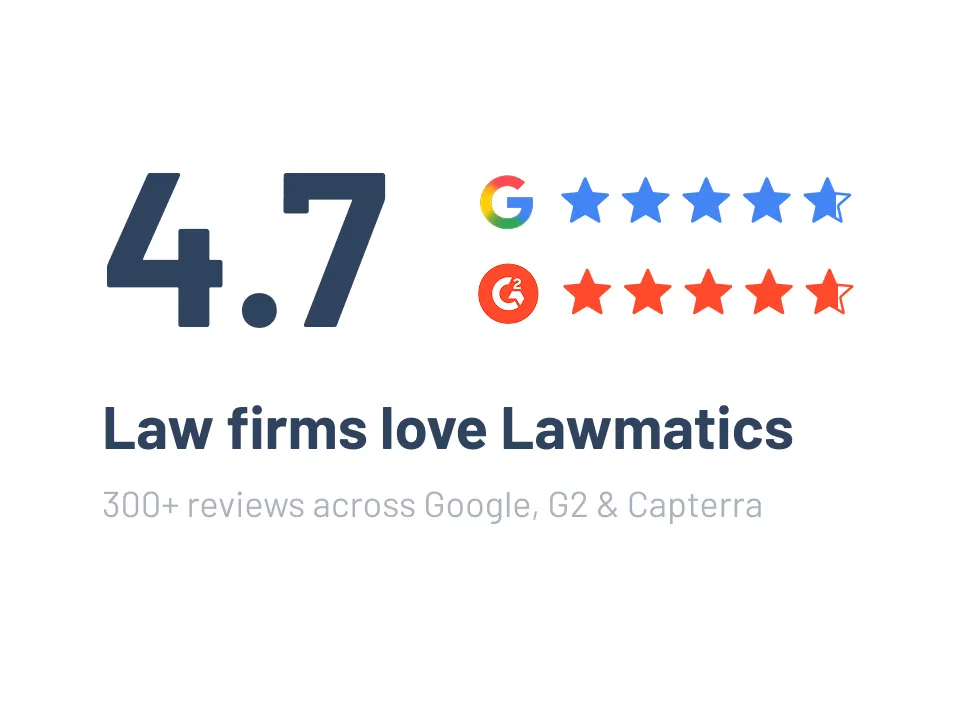




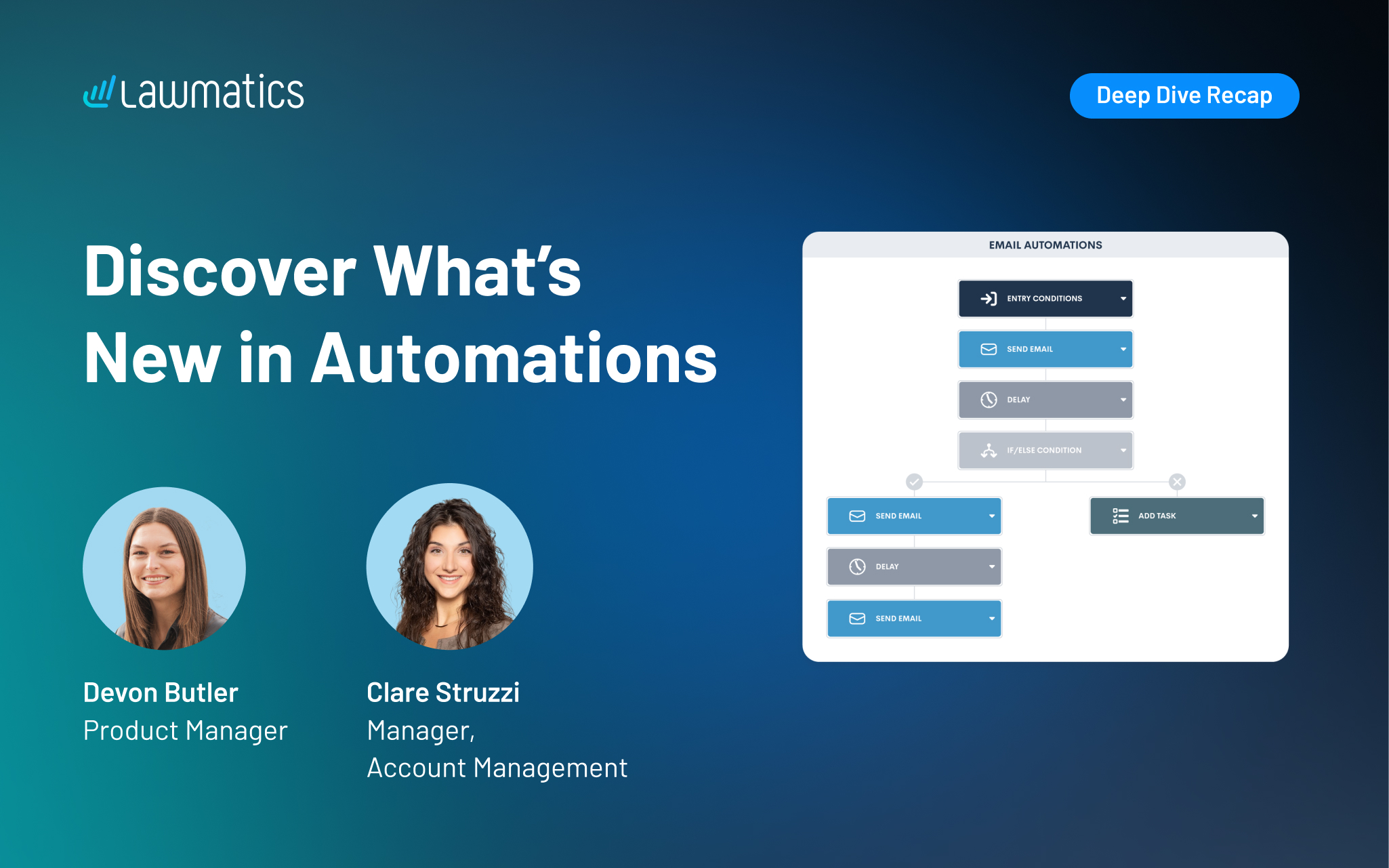


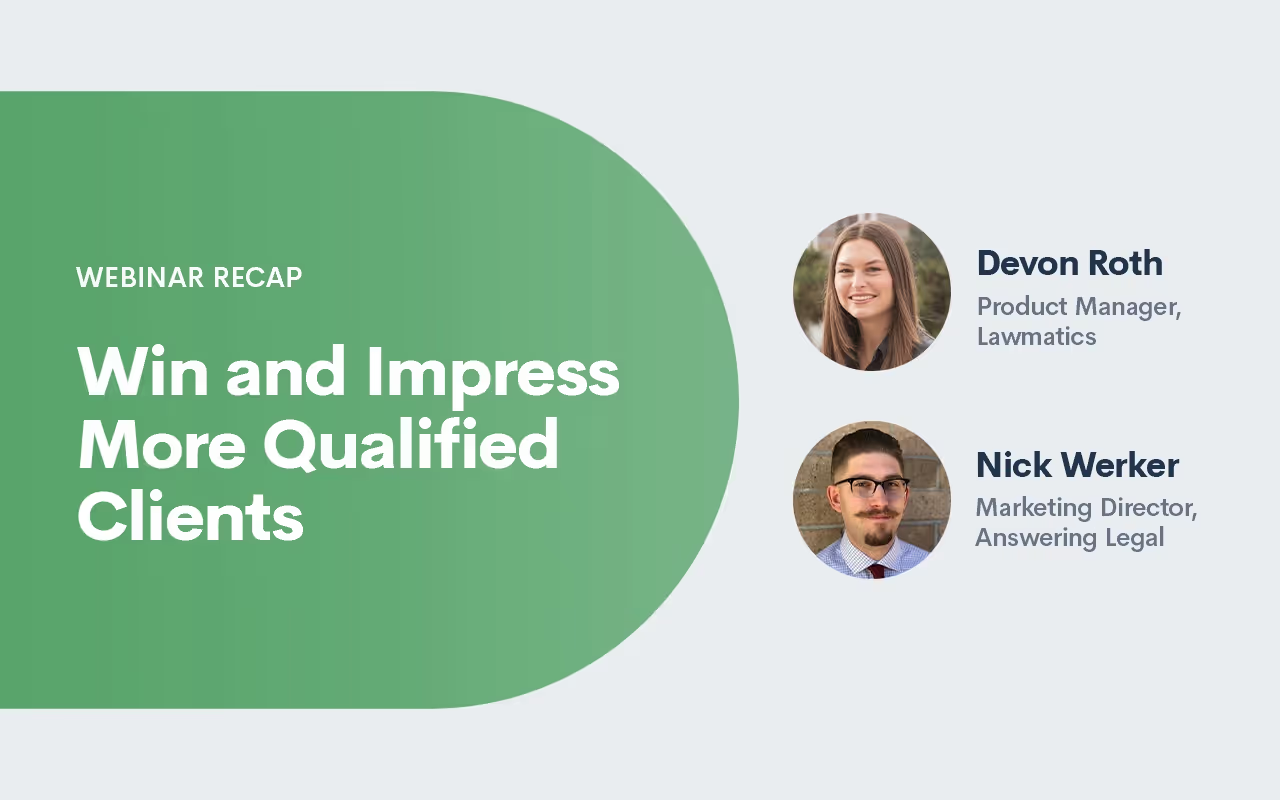
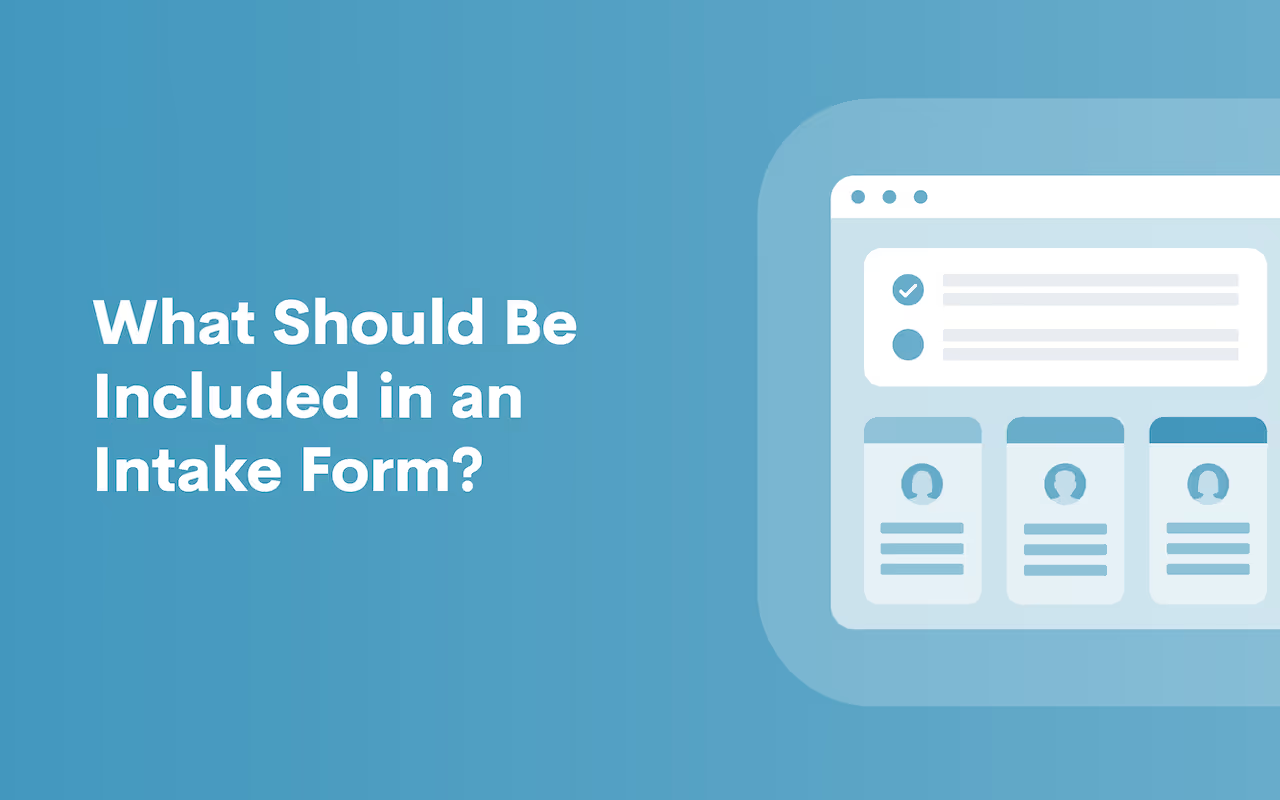
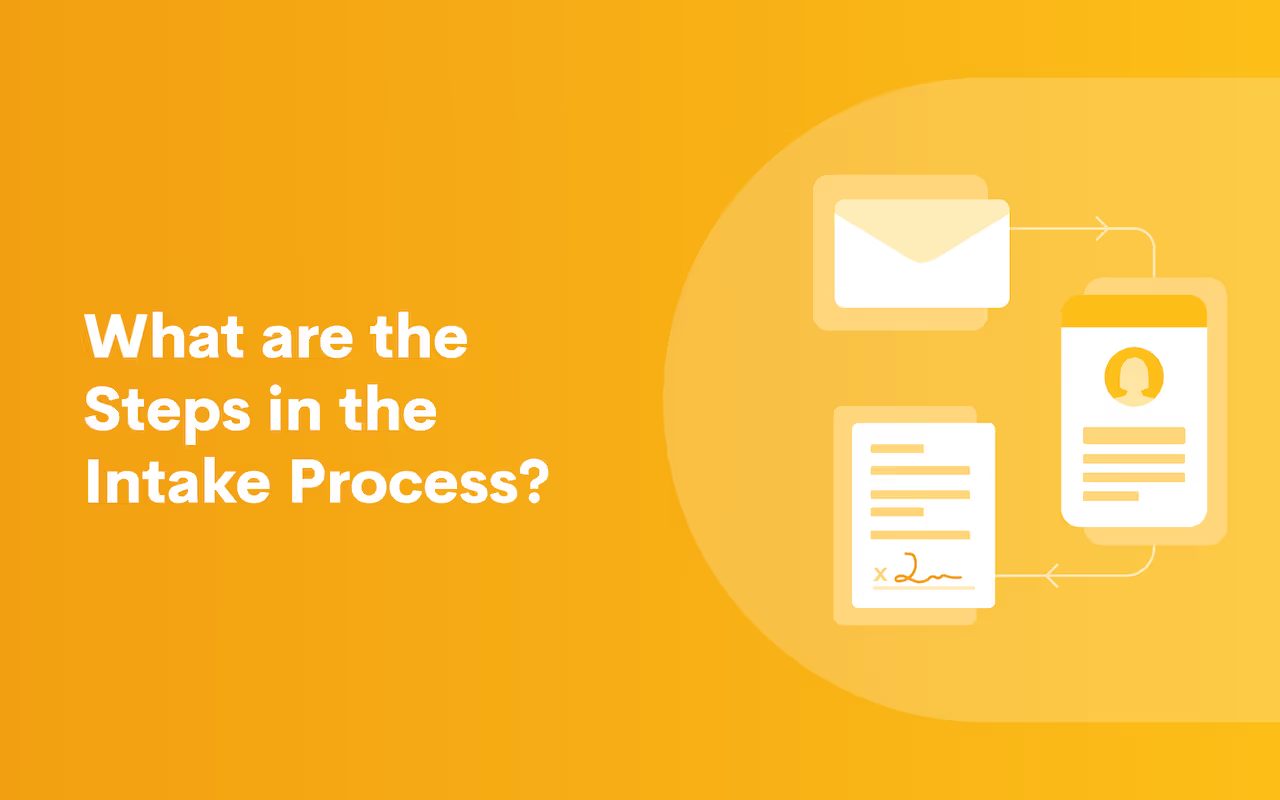
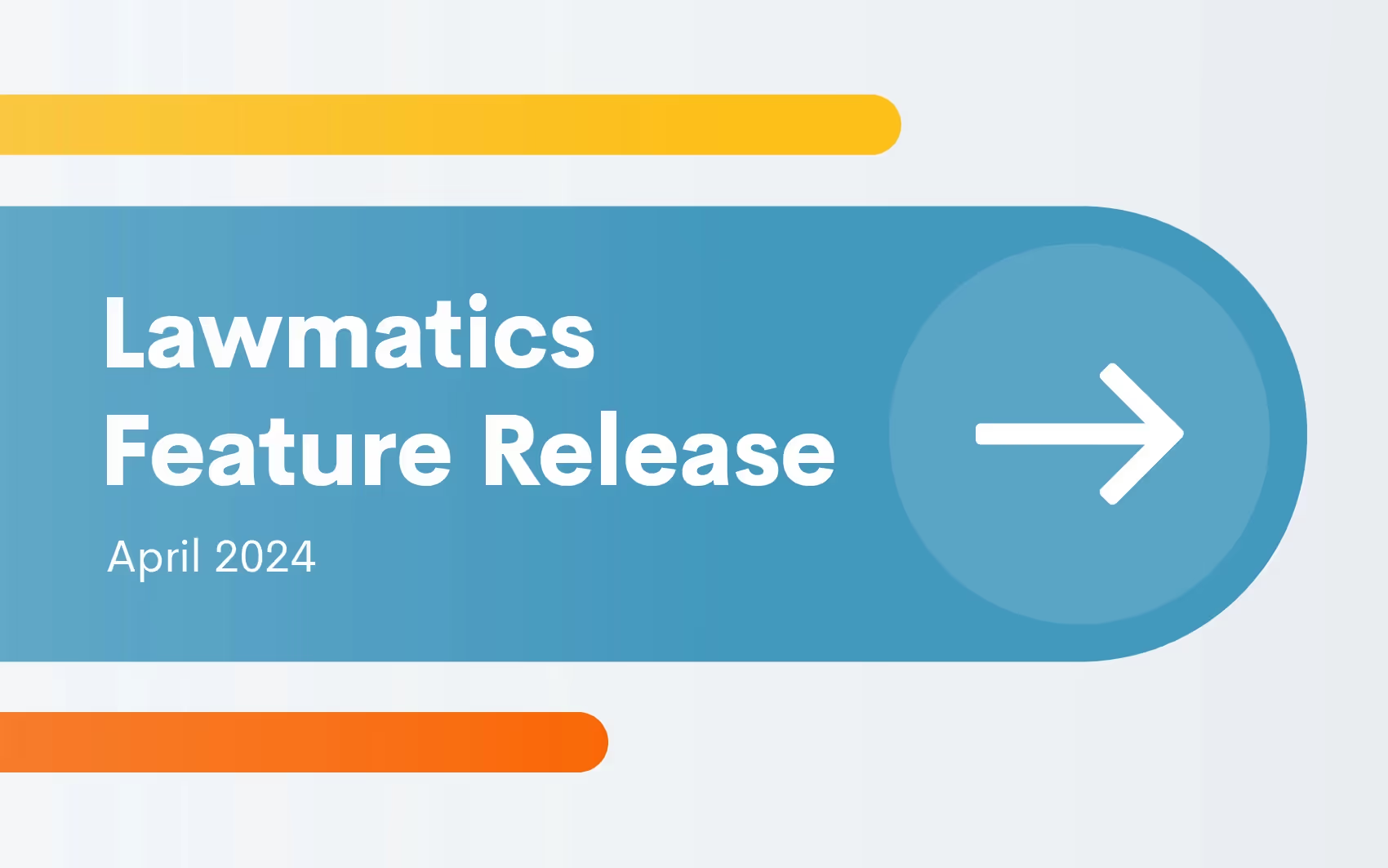
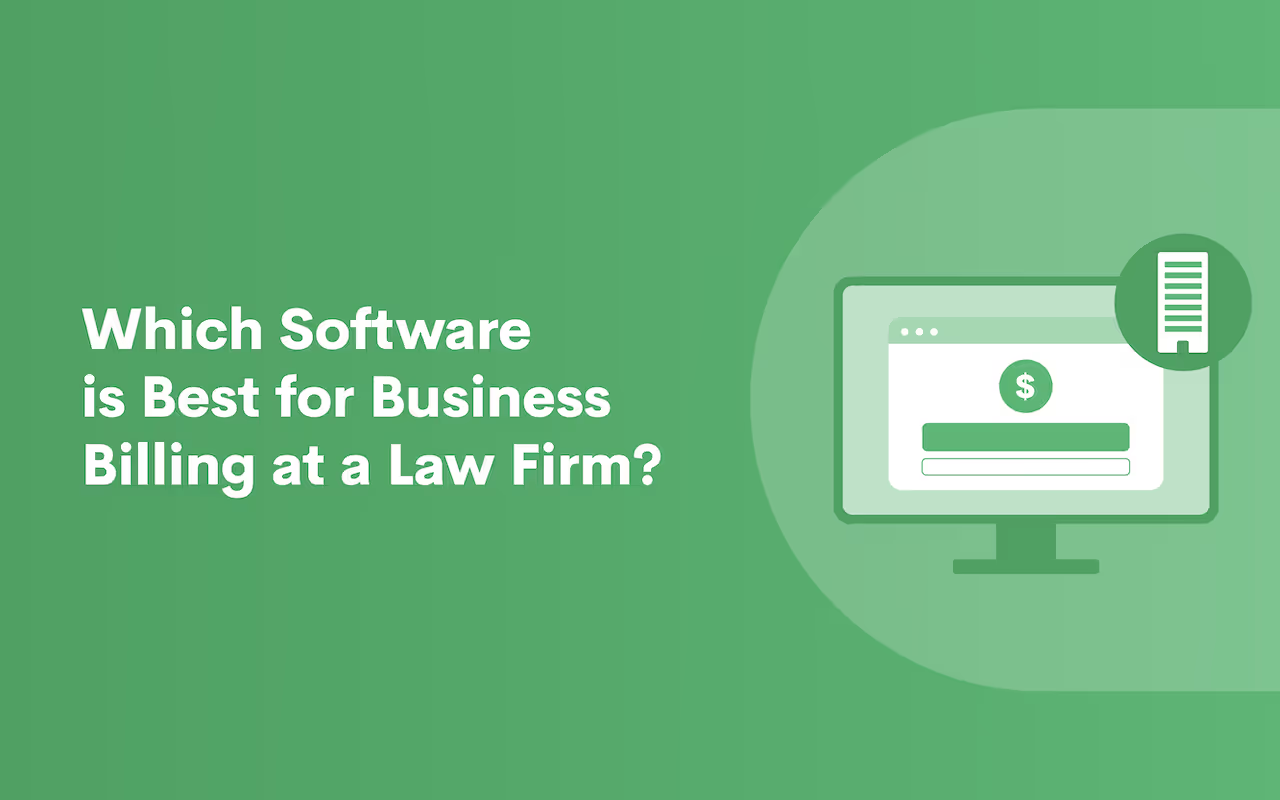

.avif)
.avif)

.avif)
